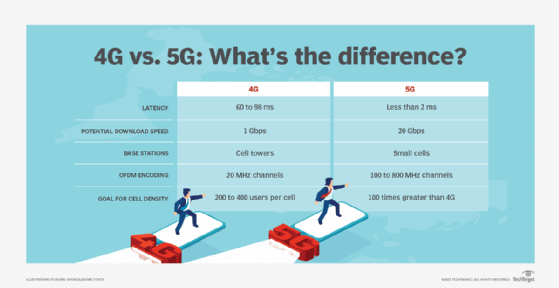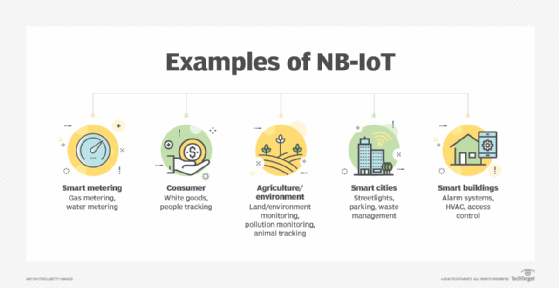LTE (Long-Term Evolution)
What is LTE (Long-Term Evolution)?
LTE (Long-Term Evolution) is a fourth-generation (4G) wireless standard that provides increased network capacity and speed for cellphones and other cellular devices compared with third-generation (3G) technology.
LTE is a technology for wireless broadband communication for mobile devices and is used by phone carriers to deliver wireless data to a consumer's phone. Over the previous iteration of 3G, LTE provided high speed, higher efficiency, peak data rates and flexibility in bandwidth and frequency.
LTE offers higher peak data transfer rates than 3G, up to 100 Mbps downstream and 30 Mbps upstream. It provides reduced latency, scalable bandwidth capacity and backward compatibility with the existing Global System for Mobile communication (GSM) and Universal Mobile Telecommunications Service (UMTS) technology. The subsequent development of LTE-Advanced (LTE-A) yielded peak throughput on the order of 300 Mbps.
Although LTE is commonly referred to as 4G LTE, LTE is technically slower than 4G but still faster than normal 3G. For this reason, LTE may also be called 3.95G. While LTE speeds reach 100 Mbps, true 4G offers speeds up to 1,000 Mbps. However, different versions of LTE meet 4G speeds, such as LTE-A.
LTE eventually became universally available as a standard that is still commonly available in areas that don't yet have 5G.
LTE has a direct role in the development of the current 5G standard, called 5G New Radio. Early 5G networks, referred to as non-standalone 5G (NSA 5G), require a 4G LTE control plane to manage 5G data sessions. NSA 5G networks can be deployed and supported by the existing 4G network framework, lowering capital and operating expenses for operators rolling out 5G.
Why is LTE called Long-Term Evolution?
The 3rd Generation Partnership Project (3GPP) developed LTE. The standard was described as the next step in the progression of mobile telecommunications as well as progression from the 2G GSM and 3G UMTS specifications. LTE is commonly marketed as 4G LTE.
LTE did not originally qualify as true 4G. The International Telecommunication Union (ITU) initially defined 4G as a cellular standard that would deliver data rates of 1 Gbps to a stationary user and 100 Mbps to a user on the move. In December 2010, the ITU softened its stance, applying 4G to LTE, as well as several other wireless standards.
How does LTE work?
An LTE network employs the multiuser variant of the orthogonal frequency-division multiplexing (OFDM) modulation scheme, called orthogonal frequency-division multiple access (OFDMA), for its downlink signal.
OFDMA enables the LTE downlink to transmit data from a base station to multiple users at higher data rates than 3G, with improved spectral efficiency. Single-carrier FDMA is used for the uplink signal, which reduces the transmit power required of the mobile terminal.
The upper layers of LTE are based on Transmission Control Protocol/Internet Protocol, which results in an all-Internet Protocol network, like that of wired communications. LTE supports data transmissions such as mixed data, voice, video and messaging traffic.
LTE-A uses multiple input, multiple output (MIMO) antenna technologies similar to that used in the IEEE 802.11n wireless local area network standard. MIMO and OFDM enable a higher signal-to-noise ratio at the receiver, providing improved wireless network coverage and throughput, especially in dense urban areas.
LTE-A requires devices to be fit with a special chip. Broadcom, Nvidia and Qualcomm all make chips that support LTE-A. A vast majority of smartphones support LTE-A.
How popular is LTE around the world?
Telephone companies launched LTE at different times in different countries. Some European carriers adopted the standard as early as 2009, while North American operators introduced the spec in 2010 and 2011.
Opensignal found that across 87 countries, the average availability of 4G networks was 80%. In 2020, the big three U.S. mobile operators -- AT&T, T-Mobile and Verizon -- scored 90% and above in the 4G availability category. 4G LTE and 5G are replacing 3G across North America and Western Europe, with major 3G networks scheduled to be shut down in 2022.
According to the Global mobile Suppliers Association (GSA), in 2022, LTE had connected two-thirds of global mobile users -- equaling 6.6 billion subscriptions. The GSA also reports that up to 791 telecom operators ran LTE networks across the globe, with 336 as LTE-A networks.

4G LTE features
LTE offers users several features, including the following:
- Audio and video streaming. LTE has faster download and upload speeds than 2G and 3G.
- Real-time connection to services. With voice over LTE, users can talk to others without experiencing lag or jitter.
- Even faster speeds with LTE-Advanced. Download and upload speeds with LTE-Advanced are two to three times faster than standard LTE. All LTE Advanced devices are backward-compatible with standard LTE.
- Carrier aggregation. This LTE-Advanced feature improved network capacity, adding bandwidth of up to 100 MHz across five component carriers (bands) with 20 MHz bandwidth each. LTE-A handsets combine frequencies from multiple component carriers to improve signal, speed and reliability.
LTE internet of things (IoT) specifications
In June 2016, 3GPP Release 13 delivered new IoT cellular connectivity options designed for IoT machine-to-machine (M2M) use. LTE-machine-type communication (LTE-M) and narrowband IoT (NB-IoT) were both based on the LTE standard, but with significant changes to enable low-power wide area network M2M operations.
LTE-M delivers data speeds of around 1 Mbps, while NB-IoT supports up to 26 Kbps in downlink. These drastically reduced data speeds increase the battery life of M2M devices that use the IoT cellular standards. For sensors and other devices that need mobility on the cellular network, NB-IoT can support a battery life of up to 10 years. LTE-M can support up to 10 years of battery life on two AA batteries, but only if the device is static and broadcasting for seconds daily. If a device is on, moving about on an LTE network and using LTE-M supported voice features, the battery life will be reduced.

What is a private LTE network?
Private LTE networks are scaled-down versions of public LTE networks. They are designed to provide private cellular coverage over a company's campus, distribution center or in airports, stadiums and other locations.
Private networks use unlicensed or shared spectrum to deliver coverage to cellphones and other devices. This includes the global, unlicensed 5 GHz band and 3.5 GHz band, which in the U.S. is called the Citizens Broadband Radio Service (CBRS) shared band.
To establish private LTE services, an organization needs an LTE microcell or small cell, core network servers and compliant devices with a SIM card. Many major cellphone manufacturers support LTE spectrum bands that can be used for private services.
Major Android phone manufacturers began to support the CBRS band in 2019. Apple introduced support for CBRS (Band 48) connections with its iPhone 11 launch in September 2019. Numerous companies produce routers, modules and modems that support the CBRS band.
What is voice over LTE?
Voice over LTE (VoLTE) technology enables users to place phone calls over the LTE network as data packets instead of as typical voice calls. This is called packet voice, and it can share packets along a network of several phone conversations.
VoLTE can support many callers and reallocate bandwidth as needed to support it. Other VoLTE features include optimization of bandwidth and enabling the user to see if the phone they intend to call is busy or available.
LTE history and development
There was no global standard for wireless broadband until the advent of LTE. Prior to LTE, GSM had caught on in Asia and Europe, but the major mobile operators in other countries, including the U.S. and Canada, had adopted Code-Division Multiple Access. The goal of LTE was to merge a fragmented market and offer a more efficient network for network operators.
Major milestones in LTE's development include the following:
- 2004. NTT DoCoMo, a Japanese mobile phone operator, proposed making LTE the next international standard for wireless broadband, and work on the LTE standard started.
- 2006. During a live demonstration, Nokia Networks simultaneously downloaded HD video and uploaded a game via LTE.
- 2007. Ericsson, a Swedish telecommunications company, demonstrated LTE with a bit rate of 144 Mbps.
- 2008. Ericsson demonstrated the first LTE end-to-end phone call, and LTE was finalized.
- 2009. TeliaSonera, a Swedish mobile network operator, made LTE available in Oslo and Stockholm.
- 2011. LTE-Advanced was finalized in 3GPP Release 10.
- 2016. 3GPP engineers began developing the 5G standard that will eventually succeed LTE.
- 2017. The first NSA 5G specification was released, becoming widely available in 2018-2019.
- 2021. 5G specification work is ongoing.

What's ahead for cellular networks?
The majority of 5G networks use the NSA spec that requires a 4G LTE core network to facilitate 5G data sessions. 4G LTE is still the major mobile network standard across the world; however, the move toward 5G is continuing to grow.
IDC predicted the number of 5G smartphones shipped in the U.S. would reach 118.1 million units by the end of 2022, up from 92.8 million shipped in 2021. IDC also predicted that 161.2 million 5G smartphones will ship by 2026 in the U.S.
Likewise, a 2022 Ericsson Mobility Report forecasts 5G subscriptions will become the dominant mobile access technology by the year 2027. According to the report, by 2028, 5G will account for 91% of mobile subscriptions in North America (although less in other world regions).
Learn more about predictions for 5G beyond 2023 in this article.







